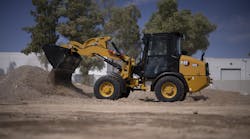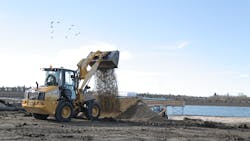Heavy equipment manufacturer Caterpillar Inc. has introduced its new Next Generation Cat 906, 907 and 908 compact wheel loaders. Among the many design changes for these machines was an overhaul of their hydraulics systems to help improve efficiency and performance.
A pressure compensated valve is now standard on these wheel loaders. According to the company, this makes it easier for operators to control machine implements as well as hydromechanical attachments. Inclusion of the pressure compensated valve provides improved lift and tilt performance which helps machine operators complete their work more easily.
Updated Hydraulics Platform Improves Efficiency
Historically, Caterpillar has used a parallel valve and a tandem valve on its M series wheel loaders, of which these new machines are a part. Standardizing use of a pressure compensated valve, however, adds new capabilities.
Elie Abi-Karam, product application Sspecialist at Caterpillar, says the pressure compensated valve is effectively the same as the one used on larger Cat machines. It is also software driven like in the company’s larger machines.
Bringing the same software and hydraulics platform to its smaller machines provides customers “great ability, controllability and fine motor functions,” says Abi-Karam. The system allows very precise movement which can benefit machine owners’ productivity by helping to ensure the can do their work accurately and reduce the need for rework.
“At the same time, we can run hydraulic tools efficiently,” he says. Operators can lift, lower and tilt attachments which the valve continuously manages to ensure they are moved in the most precise and efficient way possible.
The wheel loaders’ hydraulics can be standard or high flow, says Abi-Karam, enabling use of various Caterpillar attachments—adding versatility to the applications in which the machines can be used.
Working auxiliary pressures have been increased from previous wheel loader models which Caterpillar says makes work easier to perform and improves steering to help reduce operator fatigue.
Cylinder snubbing has also been incorporated onto the machines. When the wheel loader’s bucket is at its maximum height or full dump there is no longer a bang sensation coming into the cab and felt by the operator says Jas Kundra, sales & marketing manager, Compact Wheel Loaders at Caterpillar. Instead, there is cushioning which keeps the bucket arm’s hydraulic cylinder from causing this banging common with other machine designs which can cause discomfort for operators.
Overall, updates to the hydraulics system of these Next Generation compact wheel loaders are expected to help customers perform their work in a more productive, efficient and comfortable manner.





